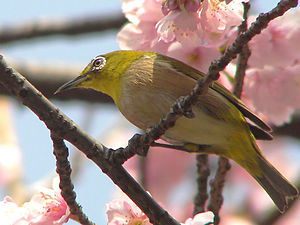Rust-flank spectacle bird
| Rust-flank spectacle bird | ||||||||||||
|---|---|---|---|---|---|---|---|---|---|---|---|---|

Rust-flanked spectacled bird ( Zosterops erythropleurus ) |
||||||||||||
| Systematics | ||||||||||||
|
||||||||||||
| Scientific name | ||||||||||||
| Zosterops erythropleurus | ||||||||||||
| Swinhoe , 1863 |
The chestnut-flanked white-eye ( Zosterops erythropleurus ) or Rotflanken glasses bird is a bird art of the genus Zosterops from the family of spectacles birds (Zosteropidae), which is native to East Asia. Its distribution area extends over the northeast of China and the southern part of the Far East of Russia . No subspecies are described.
Appearance
The rust-flank spectacle bird is a small songbird from the order of the passerine birds , which can reach a length of 10.0 to 12.0 centimeters. In appearance, the rust-flank spectacle bird is very similar to the Japanese spectacle bird and the Ganges spectacle bird . The hood and the back plumage have a light yellow-green color, the underside is white. A striking distinguishing feature compared to the Japanese spectacle bird are the rust-colored to chestnut-colored flanks that give it its name, but are less pronounced in young birds. The hand swing projection is 75 to 100 percent of the umbrella feathers and is significantly longer than that of the Japanese goggle bird. The beak has a fine point. Its top is gray, while the lower side and base are colored pink. The eyes appear large and have a black iris . Like all spectacle birds, the rust-flanked spectacle bird also has a white eye ring, which is only interrupted on the reins , the area of the bird's plumage between beak and eye.
Distribution area
The breeding areas of the rust-flanked spectacled bird extend over north-east China and south-east Siberia , the Primorye region and the area of the Amur and Ussuri . It is also likely to be found in northern North Korea . The rust-flank spectacled bird is the northernmost representative of the spectacled bird, which is particularly common in more southern Asia , Australia and Africa . The birds' stay in the northern breeding areas is therefore sometimes only two and a half months.
The wintering areas are in Southeast Asia , Vietnam , Thailand and in the south of China. During the migration, the birds can also be observed in Korea . The rust-flanked spectacled bird is very rare on the islands off the Japanese coast .
The birds gather in flocks on the train. Mixed flocks of rustflank and Japanese eyeglass birds can also be observed during the migration.
habitat
The rust-flanked spectacled bird prefers deciduous and mixed forests within its breeding area, mostly near river banks and floodplains. Here the species prefers to breed in the willow bushes on the river and lake banks. It resides in both primary and secondary forests . The rust-flanked spectacled bird reaches the breeding areas very late, in the Ussuri area around the end of May. During the migration, the birds can be found in every type of forest area. The species is quite common in parts, but prefers higher areas of around 1000 meters above sea level.
The rust-flanked spectacled bird feeds on insects which it picks up from the branches of trees and bushes.
Existence and endangerment
The IUCN classifies the rust-flank spectacle bird as not endangered ( least concern ) due to its extensive distribution area . Recently, however, there has been a slight decrease in the total population. There are no global population estimates, but national estimates assume around 10,000 to 100,000 breeding pairs in Russia and China, as well as 1,000 to 10,000 individuals migrating through Korea.
Web links
- Zosterops erythropleurus in the Red List of Endangered Species of the IUCN 2013.1. Listed by: BirdLife International, 2012. Retrieved July 25, 2013.
- BirdLife International: Species Factsheet - Chestnut-flanked White-eye ( Zosterops erythropleurus ) . Retrieved July 22, 2013.
- Videos, photos and sound recordings of Chestnut-flanked White-eye (Zosterops erythropleurus) in the Internet Bird Collection
- Rust-flanked spectacled bird ( Zosterops erythropleurus ) at Avibase; Retrieved July 25, 2013.
- Zosterops erythropleurus in the Integrated Taxonomic Information System (ITIS). Retrieved July 25, 2013.
- xeno-canto: Sound recordings - Chestnut-flanked White-eye ( Zosterops erythropleurus )
Individual evidence
- ^ A b Mark Brazil: Birds of East Asia. London 2009, p. 386.
- ↑ a b c d L. Shulpin: Zosterops erythropleurus Swinh. in Ussuriland. In: Journal of Ornithology. Volume 78, Issue 1, (January 1930), pp. 72-75.
- ^ A b John R. MacKinnon: A Field Guide to the Birds of China. Oxford 2000, p. 374.
- ^ BirdLife International 2012. Zosterops erythropleurus . In: IUCN 2013. IUCN Red List of Threatened Species. Version 2013.1. <www.iucnredlist.org>. Downloaded on July 24, 2013.